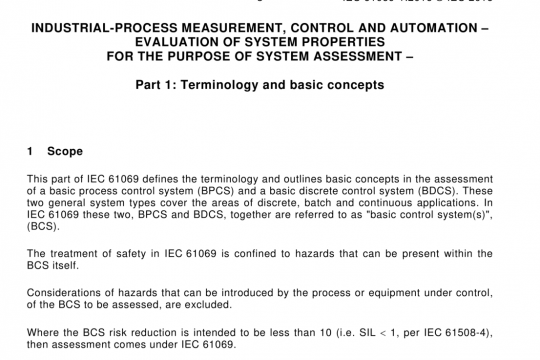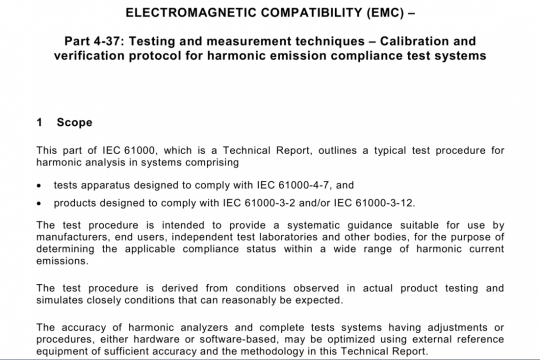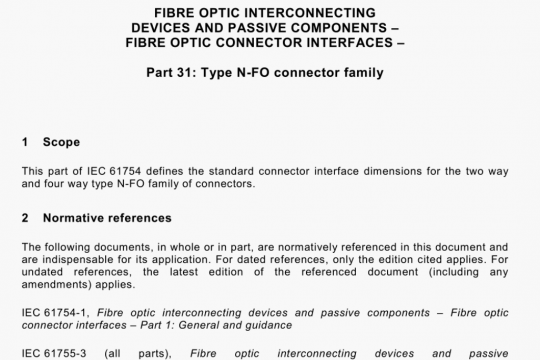BS EN IEC 60709 pdf free download
BS EN IEC 60709 pdf free download.Nuclear power plants – Instrumentation, control and electrical systems important to safety – Separation.
As a design basis for I&C and electrical systems that fulfil and/or contribute or support systems important to safety, the following general principles shall be applied to maintain the independence of redundant systems and between different systems, and to ensure that the redundancy and diversity (provided to achieve high reliability of systems important to safety) are effective. The grouping and separation criteria between the different safety classes shall be defined at the beginning of the project. — Systems which are classified to safety class 1 shall be protected from consequential effects caused by faults and normal actions within: a) redundant parts of those systems; b) systems of a lower classification; c) in some cases, between different systems classified to safety class 1 where independence is required. The faults considered shall include those internal to the l&C or electrical systems as well as those that occur as a result of events external to the l&C or electrical systems. — Systems classified to safety class 2 shall be protected from consequential effects caused by faults and normal actions within: d) redundant parts of those systems; and e) systems of a lower classification. The faults considered shall include those internal to l&C or electrical systems, but may exclude those that occur as a result of events external to the l&C or electrical systems. In cases where systems classified in safety class 2 are claimed to provide protection in the event of specific hazards, then those systems shall follow the principles of safety class 1. For example, in some countries, all systems required to achieve and maintain long-term shutdown shall be protected against fire hazard regardless of their classification. Certain systems classified in safety class 3 may need to be protected from the influences of faults in other systems. This should be determined on a case-by-case basis. Class 3 systems used to control and monitor during DEC should be protected from the influence or faults in other systems.
6.2.5 Fire protection
Fire protection requirements derived from applicable standards shall be followed.
Flame-retardant cables should be used, wherever practical. The IEC 60332 series provides guidance for the testing of electric cables to demonstrate their flame-retardant properties.
Cable tray and conduit penetrations of fire barriers (vertical and horizontal) shall be sealed with non-combustible materials to give protection at least equivalent to that required of the fire barrier.
Non-combustible materials shall be used for cable trays and conduits.
NOTE The separation of l&C and electrical systems important to safety and also the fire protection measures in existing nuclear power plants reflect the initial design. The SSCs safety classification, design standards and also fire protection requirements may have continuously evolved to more constraining requirements, therefore the existing design is often not compliant to modern standards.
6.3 EMIIEMC
EMC is a system engineering issue dealing with the balance of immunity and emissions at the interfaces between the various sub-systems.
Separation is one approach to guard against the potential CCF impact of EMI.
International EMC standards on industrial environments, IEC 61000 series and the dedicated standard for NPPs IEC 62003 should serve as the basis for the definition of the EMC requirements. These should be supplemented, where necessary, to cover the EMC environments of generating power plant components, which might be more demanding.
6.4 Electrical fault
The I&C or electrical system shall be either protected or be able to tolerate the faulty insertion of a systems own internal voltage and any credible external voltage, current (overvoltage barrier, short circuit I overcurrent barrier) and ensure the autonomy (electrical nonreactive, electrical insulation) of signal multiplication and transmission.
6.5 Requirements from non-nuclear technical standards
Requirements induced by other technical topics such as heat dissipation of components and cables (acceptable thermal loading) and escape route ways, etc., should also be considered in the project separation concept.
6.6 Requirements from special operating conditionsBS EN IEC 60709 pdf download.




